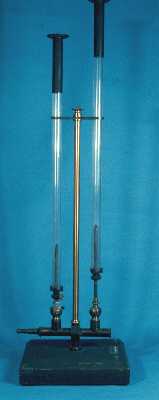

|
Dartmouth College
Oberlin College
The chemical harmonica is a special case of
the singing flame: a gas flame is set into oscillation when enclosed in a
glass tube, thereby producing a loud sound of definite pitch. Faraday proposed
that the flame was extinguished and rekindled by the hot burner at the same
frequency as the singing sound. Wheatstone and Tyndall used a rotating mirror
to show that Faraday's hypothesis was, indeed, correct. The image of the
flame, viewed in the rotating mirror which supplied a time base, could be
seen to oscillate up and down. The fundamental wavelength is twice the length
of the glass tube, after making the necessary end corrections.
| The Dartmouth apparatus is by Max Kohl of
Chemnitz, and is listed at 40 Marks in the 1900 Kohl catalogue.
This effect was later used in a late nineteenth century
musical instrument called the Pyrophone, which has an octave and more of glass
pipes with small gas flames burning at the fine orifices at the ends of the
supply pipes. When a key is depressed, a larger flame iss produced, causing
the corresponding pipe to speak. The Science Museum in London has an example,
which is shown at the right. The Singing Tubes Apparatus
is essentially similar. |
REFERENCE: Thomas B. Greenslade, Jr., "Nineteenth Century Textbook Illustrations XXXVIII: The Chemical Harmonica", Phys. Teach., 19, 42-43 (1981)